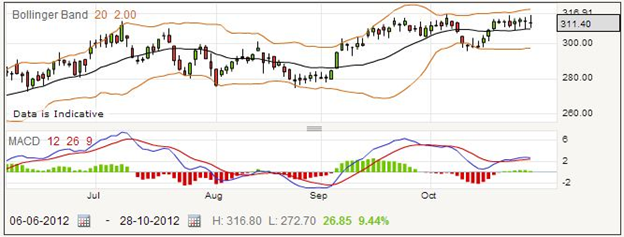Balfour Beatty Fundamentals
Balfour Beatty has been in business for more than one hundred years, and is one of the giants in construction of infrastructure – think Docklands Light Railway, the Channel Tunnel, and many other widely recognized projects. Although it is a large long-established company, the daily price chart below shows that its share price exhibits volatility that make it very suitable for spread betting.

As with nearly all construction companies, its value sank during the global economic crisis, and in the long-term has not yet returned to the same levels. It combines many different types of expertise in providing construction services, professional services, support services, and infrastructure investments. It works in over 80 countries, including the UK, the US, the Middle East, Asia, and Australia.
Balfour Beatty was named after and still retains the names of its original two founders, Balfour being a mechanical and electrical engineer and Beatty an accountant. From the start it developed tramways, but expanded more into general construction because of World War I. When Balfour was elected to Parliament in 1918, he played a part in the establishment of the National Grid, and Balfour Beatty also worked on Scotland’s hydroelectric system.
The founders had died by the time the Second World War ended, and Balfour Beatty was kept busy with the construction work, followed by its normal peacetime construction of railways and power stations. Venturing away from its traditional construction work, in 1986 it started work on residential housing, but following a downturn in the industry this side was eventually sold to Westbury in 1995.
Balfour has continued to expand, making many acquisitions in recent years, including US companies such as Parsons Brinckerhoff and GMH Military Housing. The daily price chart above shows a measure of volatility but not unreasonable predictability, making this company worth some study for spread trading.
Balfour Beatty Rolling Daily: How to Spread Bet on Balfour Beatty shares?
Before you do any spread betting or trading, you need to form a plan to analyze the stock, deciding if and how far the price will move. Say you looked at Balfour Beatty, current rolling daily price 310.52 – 312.08, and decided it was going up. You might place a long bet for £7.50 per point.
Suppose your bet turned out right, and you decided to close the bet and collect your winnings when the quote went up to 365.75 – 367.18. You could calculate how much you have won like this: –
- Your bet started at 312.08
- Your bet closed at 365.75
- Therefore you have gained 365.75 minus 312.08 points
- This works out to 53.67 points
- You bet £7.50 per point
- Therefore you have won £402.52
No matter how carefully you analyze a stock, you will have some spread bets that fail, and require you to close them for a loss. Say the price dropped to 275.13 – 277.05. You can work out your losses in exactly the same manner: –
- Your bet started at 312.08
- Your bet closed at 275.13
- Therefore you have lost 312.08 -275.13 points
- This works out to 36.95 points
- You bet £7.50 per point
- Therefore you have lost £277.12
Many spread traders and others in the markets use the stop loss order, which tells your broker to close your bet if it is losing by a certain amount. This means you do not have to be monitoring the markets all the time. Say your stop loss order activated and ended your bet when the quote was 281.62 – 283.15.
- Your bet started at 312.08
- Your bet closed at 281.62
- Therefore you have lost 312.08 – 281.62 points
- This works out to 30.46 points
- You bet £7.50 per point
- Therefore you have lost £228.45
Balfour Beatty Futures Style Spread Bet
With a medium-term view of the market, you may be tempted to use the futures style spread bet, as it does not entail any account adjustments when the bets are rolled over. The current quote for Balfour Beatty is 311.40 – 315.16 for the far quarter, about eight months away at the moment.
You might consider that the price of Balfour Beatty is going down in the next few weeks or months. Then you would be interested in placing a short or sell bet on the stock, staking perhaps £15 per point at the selling price of 311.40. If the price does go down, you could close the bet and collect your profits when the quote is 254.51 – 258.03. Working this out, the starting price was 311.40, and you chose to close the bet when the buying price was quoted at 258.03. The difference between these is 53.37 points. Multiplying by £15, you find you have won £800.55.
Of course, financial trading is difficult and you must expect a share of losses. Perhaps in this case after you placed the bet the price started going upwards, and you decide to close the bet and accept your loss when it reached 354.78 – 358.22. Your starting price was still 311.40, but this time your losing bet closed at 358.22. That means you lost 46.82 points. For your chosen size of stake that is a loss of £702.30.
Many traders and spread betters decide to use a stop loss order, which covers closing the bet even if they are not watching the market or even online when the price changes. With one of these, your spread betting provider might have closed your bet when the price went up to 342.91 – 346.43. 346.43 minus 311.40 is a total of 35.03 points that you lost on the bet, so your wager would cost you £525.45.